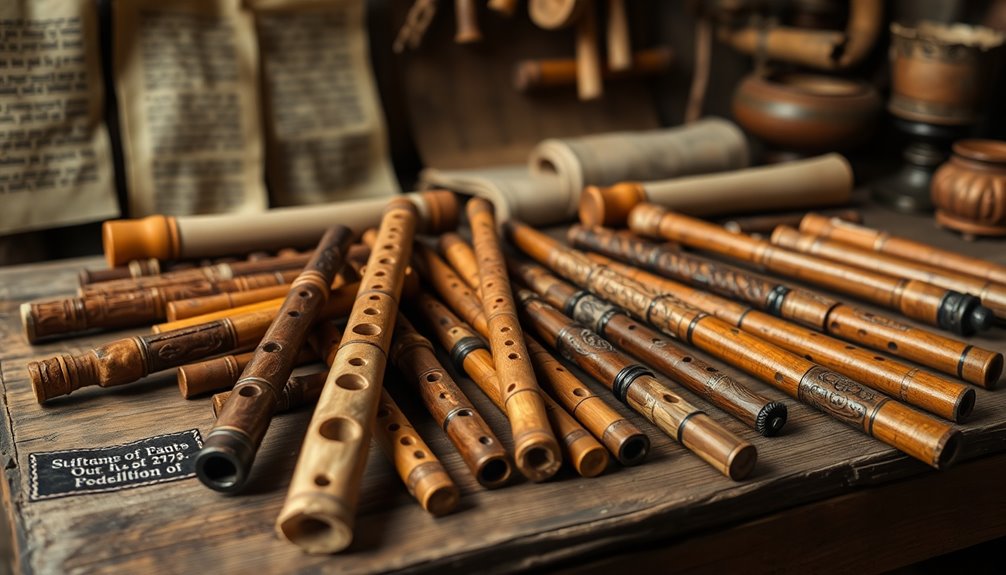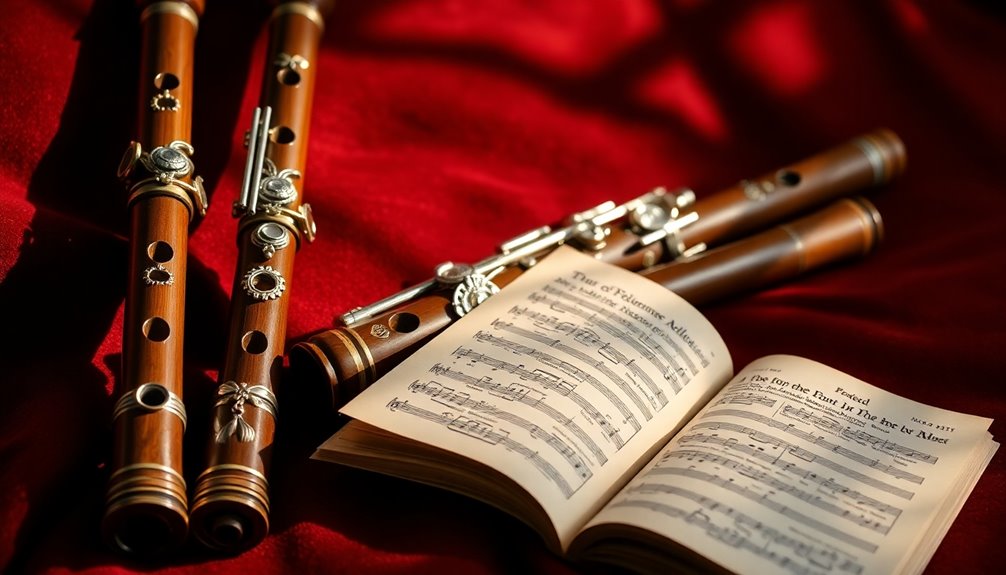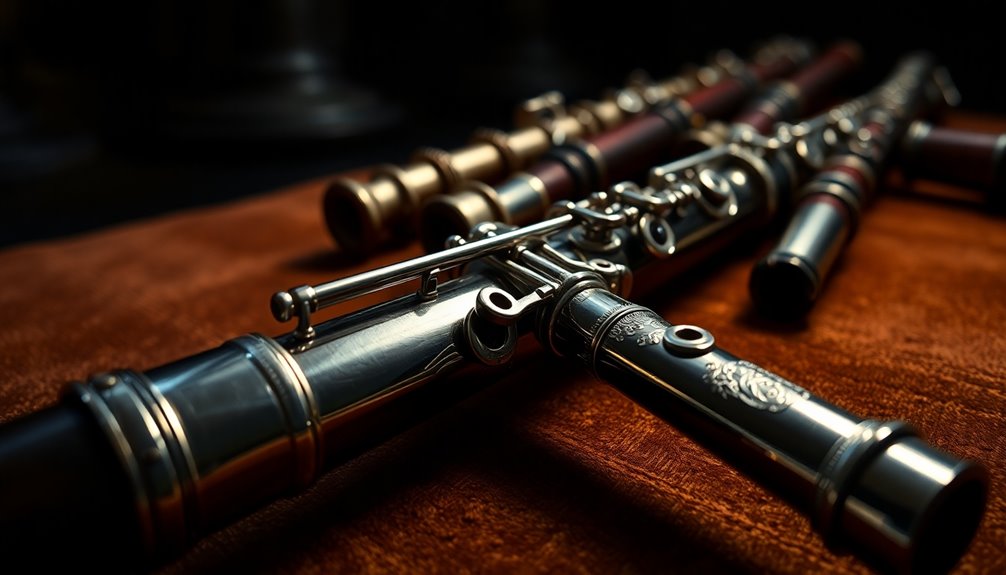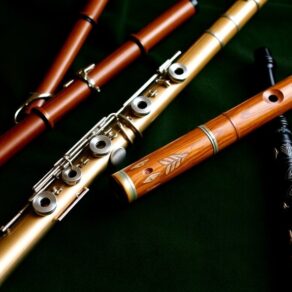Exploring the different flute designs through history reveals significant cultural and technological influences. You'll find early flutes made from materials like bone and wood, integral to ancient rituals and storytelling. As you progress, Renaissance flutes showcase enhanced craftsmanship, while Baroque innovations introduced keyed designs for greater range. The Boehm system transformed classical flutes into metal instruments, boosting sound quality and ergonomic features. Today, modern designs reflect diverse musical styles and player preferences, emphasizing comfort and aesthetics. Each design evolution not only illustrates technological advancements but also connects musicians to their cultural heritage, highlighting the rich tapestry of flute history that awaits your discovery.
Key Takeaways
- Flute history spans over 35,000 years, showcasing diverse designs from early bone and bamboo flutes to modern metal variations.
- Renaissance flutes featured increased finger holes, enhancing tonal range and showcasing craftsmanship and aesthetic beauty.
- The Baroque period introduced keyed flutes and wider bore designs, expanding sound capabilities and repertoire.
- The Boehm system revolutionized flute design, transitioning from wood to metal, improving finger flexibility and sound quality.
- Cultural variations, like bamboo flutes in Asia and Native American flutes, reflect unique musical traditions and societal significance.
Ancient Flute Origins

The history of the flute dates back over 35,000 years, making it one of the oldest musical instruments still in use today. You might find it fascinating to learn that the earliest flutes were crafted from ancient materials like bone, wood, and even bamboo.
These early instruments reveal a profound connection to the cultures that created them, serving not only as musical tools but also as symbols of social and spiritual significance.
As you investigate deeper into the flute's evolution, you'll discover that these primitive designs laid the groundwork for more sophisticated forms. For instance, the discovery of flutes made from bird bones and mammoth ivory indicates a rich tradition of craftsmanship and artistry.
Each flute represented unique cultural expressions, reflecting the values and beliefs of the communities that played them.
In various ancient civilizations, such as those in China and India, flutes were integral to rituals and storytelling, enhancing the emotional depth of their performances. The development of various types of flutes, such as the Western Concert Flute, showcases the diverse approaches to flute design over time.
The shift from simple tube-like structures to more complex designs, featuring finger holes and varied sizes, showcases humanity's ingenuity in maximizing sound quality and versatility.
These evolutionary steps not only highlight the technical advances in flute design but also emphasize the shared human experience of music-making across millennia.
As you explore these ancient origins, you might feel a sense of belonging to a timeless tradition, connecting you to countless generations who found joy and meaning in the sweet, haunting melodies of the flute.
The Renaissance Era

Renaissance flutes marked a pivotal transformation in the instrument's design and cultural significance, reflecting the era's broader artistic revival. During this period, flutes underwent significant refinement, showcasing Renaissance craftsmanship that emphasized both aesthetic beauty and functional improvement. The instruments became more sophisticated, with an increase in the number of finger holes that allowed for greater tonal range and versatility.
You'd notice that the wooden flutes crafted in this era were often made from fine materials like boxwood, adorned with intricate carvings that highlighted the artisan's skill. This craftsmanship not only enhanced the flute's sound but also made it a visual centerpiece in musical ensembles.
The rise of flute ensembles during the Renaissance signified a shift in performance practice, as musicians sought to explore rich harmonic textures and intricate counterpoint. As these ensembles gained popularity, flutists began to play together in more structured settings, fostering a sense of community among musicians.
The social aspect of music-making flourished, and you'd find gatherings where these ensembles performed for both the nobility and the common folk. This inclusivity was crucial to the cultural fabric of the time, allowing people from various backgrounds to appreciate the beauty of the flute and its music. Additionally, the introduction of key mechanisms during this period improved fingerings and playability, allowing for more expressive performances.
In essence, the Renaissance era didn't just reshape the flute; it revitalized the art of music itself, creating a profound connection between the instrument, the musicians, and the audiences who cherished their performances.
Baroque Flute Innovations

As the Renaissance gave way to the Baroque period, flute design took another significant leap forward, embracing innovations that enhanced both playability and expressive capabilities.
During this time, baroque craftsmanship flourished, resulting in instruments that not only looked exquisite but also offered a richer tonal palette. You'll notice that flutes from this era often featured a wider bore, allowing for a more powerful sound and increased volume. This change was essential for musicians aiming to be heard in larger performance spaces.
Additionally, the introduction of the keyed flute marked a pivotal moment in flute evolution. By adding keys, makers enabled players to reach a broader range of notes, particularly in the higher registers. This innovation not only expanded the flute's repertoire but also allowed for greater expressiveness in performance. You could now explore intricate melodies and harmonies that were previously challenging or impossible to play.
The materials used in Baroque flutes also reflected a shift in focus. While earlier flutes were primarily made of wood, the Baroque period saw artisans experimenting with various types of wood and even metals, each contributing unique tonal qualities. Open-hole flutes are a modern iteration that continues to enhance player control and sound dynamics.
You'll find that the craftsmanship of this era laid the groundwork for modern flutes, blending functionality with artistry.
Classical and Romantic Designs

Flute designs underwent remarkable transformations during the Classical and Romantic periods, with three key developments standing out.
First, the advent of the Boehm system in the 19th century revolutionized how flutists approached classical techniques. This system introduced a more complex key mechanism, allowing for greater finger flexibility and enabling players to execute rapid passages with ease. You might appreciate how this shift not only improved intonation but also expanded the flute's range, making it more versatile for composers of the time.
Second, the materials used in flute construction evolved considerably. Whereas earlier flutes were primarily made of wood, the Romantic era saw an increase in the use of metal, particularly silver. This change not only impacted the instrument's sound, giving it a brighter, more brilliant tone, but also contributed to the development of romantic expression. You can imagine how composers like Franz Schubert and Robert Schumann utilized this richer sound palette in their orchestral and chamber works.
Finally, the design of the flute's headjoint became more sophisticated. The introduction of the curved lip plate and embouchure hole adjustments allowed flutists to explore a wider array of dynamics and tonal colors. This innovation encouraged personal expression, fostering a sense of belonging among musicians who sought to convey their unique interpretations. Additionally, modern brands like Muramatsu have continued to refine these elements, ensuring that contemporary flutists can experience the full potential of their instruments.
Together, these developments during the Classical and Romantic periods not only shaped the flute's design but also enriched its role in both solo and ensemble settings, creating a deeper connection between the instrument and its players.
Modern Flute Variations

Numerous modern flute variations have emerged, reflecting diverse musical styles and player preferences. As you explore these contemporary flutes, you'll notice how advancements in technology and design have notably shaped their construction. Many modern flutes utilize materials like silver, gold, and even platinum, enhancing their tonal qualities while maintaining durability. The use of modern materials allows for a brighter sound and better projection, making them suitable for various performance settings.
You'll also find that ergonomic features have become increasingly important in flute design. Modern flutes often incorporate key placements that cater to the natural hand position, making them more comfortable to play for extended periods. This focus on ergonomics not only improves playability but also helps reduce the risk of injury, allowing players to express themselves more freely.
In addition to these functional aspects, modern flute variations are designed with aesthetics in mind. You may encounter flutes with intricate engravings or unique finishes that reflect your personal style. These options foster a sense of belonging within the music community, as players can choose instruments that truly resonate with them.
Whether you're drawn to the sleek design of a professional concert flute or the playful spirit of a piccolo, modern variations cater to your individual tastes and needs. By embracing these innovations, you'll discover a world where tradition meets contemporary expression, enriching your musical journey. Moreover, investing in premium intermediate flutes can elevate your performance experience, providing both quality and versatility for aspiring musicians.
Cultural Flute Diversity

Exploring the rich tapestry of cultural flute diversity reveals how different societies have shaped the instrument to reflect their unique musical traditions and values. Each region has its own distinctive styles, highlighting the cultural significance of the flute in various contexts. From the bamboo flutes of Asia to the wooden and metal designs in Europe and the Americas, these instruments tell stories of heritage and identity.
Consider the following table that illustrates a few iconic flutes and their regional significance:
| Flute Type | Cultural Significance |
|---|---|
| Bansuri (India) | Used in classical and folk music, symbolizing spirituality and love. |
| Native American Flute | Represents harmony with nature, often used in healing ceremonies. |
| Shakuhachi (Japan) | Associated with Zen Buddhism, embodying meditative practices and simplicity. |
These regional styles not only showcase diverse craftsmanship but also reflect the values and narratives of the cultures they belong to. The Bansuri, for instance, is not just an instrument; it's a conduit for expressing devotion and emotional depth. Similarly, the Native American flute serves as a bridge connecting the musician to the natural world, evoking a sense of belonging and unity. The versatility of concert flutes enhances their presence across various musical genres, further emphasizing their importance in cultural expressions.
Frequently Asked Questions
What Materials Were Used to Make Ancient Flutes?
When you look at ancient flute construction, you'll notice a variety of materials used, each with its unique properties.
Early flutes were often crafted from wood, bone, or reeds, providing natural acoustics and resonance. Some cultures even utilized clay or metal, showcasing their innovation.
These ancient materials not only influenced the sound quality but also reflected the resources available in different environments, connecting you to the artistry and culture of the past.
How Have Playing Techniques Evolved Over Time?
Playing techniques have evolved notably, reflecting various technique variations shaped by cultural influences.
You'll notice how early flutists focused on breath control and finger positioning, while modern players incorporate advanced articulations and extended techniques.
As different musical styles emerged, so did the need for adaptability in playing methods.
This evolution not only showcases individual expression but also connects you to a rich tapestry of cultural heritage, enhancing your understanding and appreciation of the flute.
Who Were Notable Flute Makers Throughout History?
Like a master painter bringing a canvas to life, notable flute makers have shaped the instrument's evolution.
Historical influences, such as the craftsmanship of Theobald Boehm, revolutionized design, enhancing playability and sound quality.
Similarly, Louis Lot and his innovations in key placement transformed how you experience music.
Each maker's unique approach invites you into a rich tradition, fostering a sense of belonging among musicians who appreciate the artistry behind their beloved flutes.
What Impact Did Technology Have on Flute Design?
Technology's impact on flute design is profound.
You'll see that digital innovation has led to precision crafting and customization, allowing for tailored instruments that suit individual players.
Additionally, acoustic enhancements have improved sound quality, enabling flutists to achieve richer tones and greater projection.
These advancements not only elevate performance but also foster a sense of belonging in the musical community, as players now have access to instruments that truly reflect their unique styles and preferences.
How Do Modern Flutes Compare to Historical Models?
When you compare modern flutes to historical models, you'll notice significant differences shaped by modern advancements and design innovations.
Today's flutes often feature improved materials, offering better durability and sound quality. The keypads and mechanisms are more precise, enhancing playability and tuning stability.
These changes reflect a shift in craftsmanship, as modern flutes cater to a wider range of musical styles, making them more versatile and accessible for players like you.
Conclusion
As you explore the evolution of flute designs, from the ancient bamboo flutes of China to the intricate silver flutes of the Baroque period, you see how each era reflects its cultural context and musical needs. Take, for example, the shift from wooden to metal flutes in the 19th century, which allowed for greater volume and tonal clarity. This journey through history not only highlights the instrument's adaptability but also enriches your appreciation for its diverse expressions across cultures.






